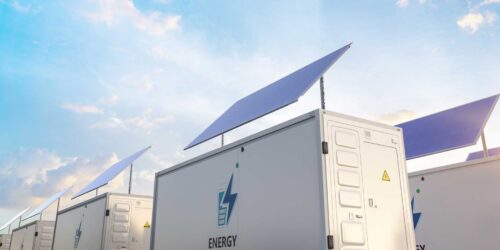
Reality Check: Generator-Centric Disaster Response Is Out of Gas
Solar-plus-storage microgrids, not generators, are a proven approach to resilience.
To most, flicking on the lights every morning is not a matter of life or death. It’s just part of the morning routine, coming somewhere after stopping the alarm and before starting the coffee maker. But, as Hurricane Beryl demonstrated earlier this summer, access to electricity can become an extremely serious matter. Sadly, 12 of the 22 deaths reported in the Houston area were due to power outages. This included 11 community members that suffered heat-related illnesses because they did not have power to cool their homes as temperatures climbed above 90 degrees Fahrenheit, and a community member that could not run her oxygen machine without power. This list does not include two others in Galveston County who lost their lives from carbon monoxide poisoning caused by improperly using generators.
Many critical facilities like hospitals, police and fire stations, cooling and dialysis centers, and grocery stores lacked backup power during the outage. Contrary to the comments from the Houston Mayor and the disaster response status quo, the generators enlisted to help are a broken, band-aid solution, and do not provide true energy resilience.
As more powerful hurricanes like Beryl hit land and coincide with record heat, having resilient and reliable electricity is key to maintaining public health. Solar-plus-storage microgrids — solar panels paired with battery storage and control systems that allow them to operate both with and without grid power — allow the creation, storage, and use of electricity on-site. They should be deployed widely at critical facilities, can help during either calm or crisis, and will put communities in a safer position for the next storm.
The Myth: Fossil fuel generators are the best way to provide electricity during outages
During extended outages, cities like Houston do not need generators — they need resilient power, and generators struggle to reliably perform and present a host of other challenges.
For one, they are expensive. When many critical facilities could not operate without power, Houston Mayor John Whitmire lamented on the lack of generators: “It’s a shame we have to get in a crisis to recognize that the city has not provided generators for essential services.” Meanwhile $800 million worth of “mobile” generators purchased by CenterPoint to provide electricity during disasters largely sat inactive as, according to the utility, they were too large to be moved and deployed. This cost, along with a 6.5 percent profit on the investment, was covered by ratepayers. Even if these expensive systems do work during disasters, they are generally not used when there is power from the grid, which can make them tough to justify financially, especially for critical facilities that would need them deployed on their sites.
Generators are also a public health risk. Sadly, the generator-caused fatalities that happened during Beryl often occur when disasters hit — theUS Consumer Product Safety Commission estimates that approximately 85 people die every year from carbon monoxide poisoning caused by generators.
Lastly, the combustion associated with generators means that they require diesel that is reliant upon fragile supply chains and significant maintenance. Both can be hard to come by during a disaster as providers often become overwhelmed with customers. Money spent on generators could go much further if spent on modern solutions to energy resilience.
The Reality: Solar-plus-storage microgrids provide resilience, save money, and cut emissions
Renewable energy systems, including solar-plus-storage microgrids, have a proven record of providing resilient electricity after storms. In Puerto Rico after Hurricane Fiona in 2022, when the entire island lost power, solar-plus-storage microgrids enabled community members in Adjuntas to receive dialysis and meant that a fire station in Guanica could continue to dispatch responders.
In many utility jurisdictions, the solar power generated will lead to utility bill savings. These systems present no air quality health risks (unlike generators), can help organizations and areas meet their carbon emissions targets, and are eligible for valuable federal funding programs.
Solar-plus-storage microgrids not only provide support after storms, but they can also play a valuable role for community energy during blue sky days, making them a desirable investment so that communities immediately start earning dividends. When solar-plus-storage microgrids are not being used to provide emergency back-up power, which is the majority of the year, they can serve as valuable parts of a virtual power plant (VPP) a collection of distributed energy resources like home and business batteries, solar arrays, and smart thermostats that help balance electricity demand and supply on the grid.
The US Department of Energy has identified the unique role that microgrids can play and asserts that they should serve as “essential building blocks of the future electricity delivery system to support resilience, decarbonization, and affordability.” Community leaders should explore the wide range of Inflation Reduction Act funding streams available to cover these systems including elective pay tax credits and innovative programs like the $27 billion Greenhouse Gas Reduction Fund, and start talking to their utilities about the potential bill savings associated with installing these systems.
It’s time for a proactive approach to energy resilience
Preparing for hurricanes is critical — it is not a matter of if, but when, the storms will come. Proactive solutions, like solar-plus-storage microgrids, can help during storms and normal day-to-day uses alike, and once built, are already in place when they are needed in times of crisis. It’s beyond fortunate that the same solutions that can help communities weather an increasingly extreme climate are also part of the solution to mitigate the damage that has already been done, all while saving our communities money. For our safety and our savings, we should leave gas-powered generators in the dust.
Are you interested in and/or working on developing solar-plus-storage microgrids with resources from the Inflation Reduction Act in your community? We would love to connect about your work. Please reach out to Michael Liebman at MLiebman@rmi.org.